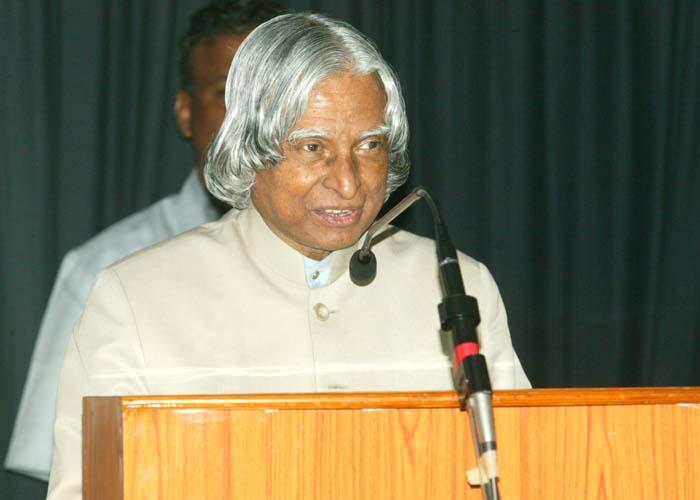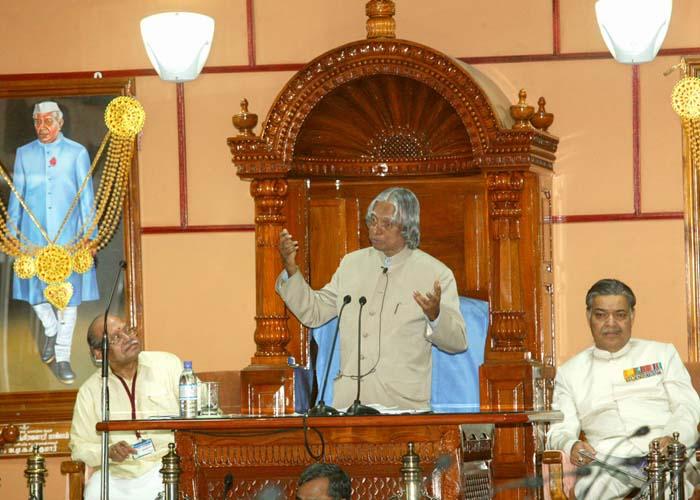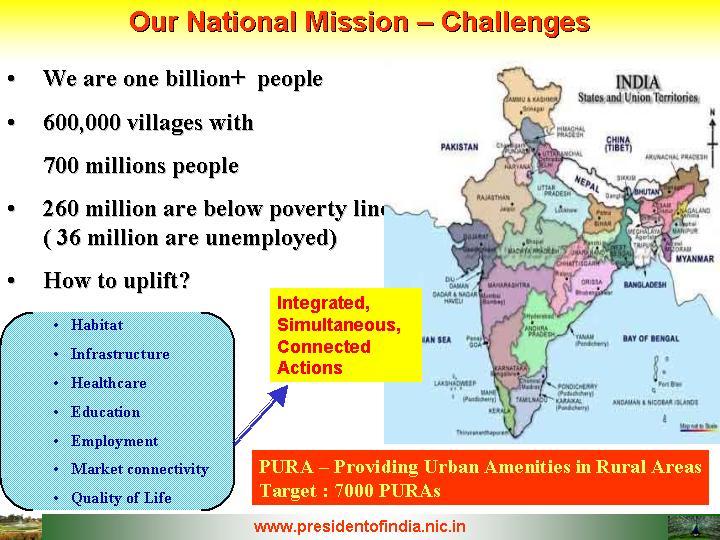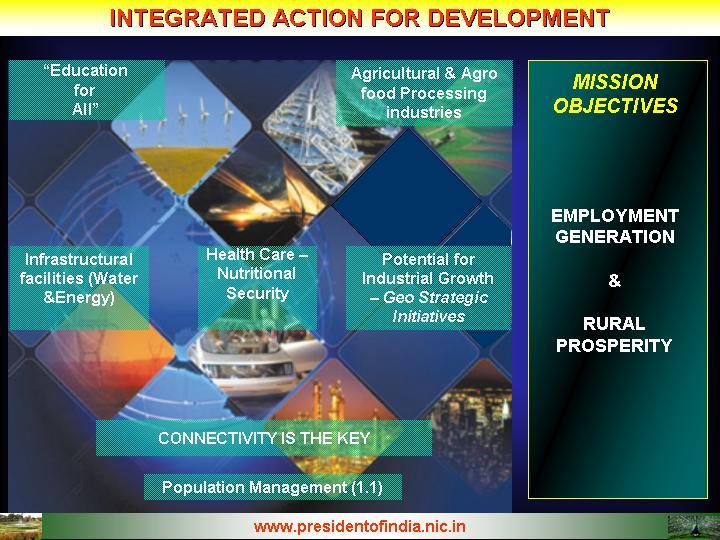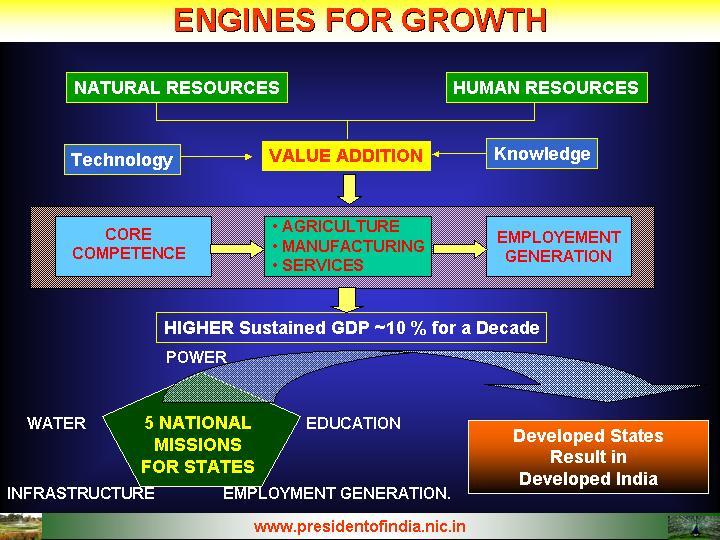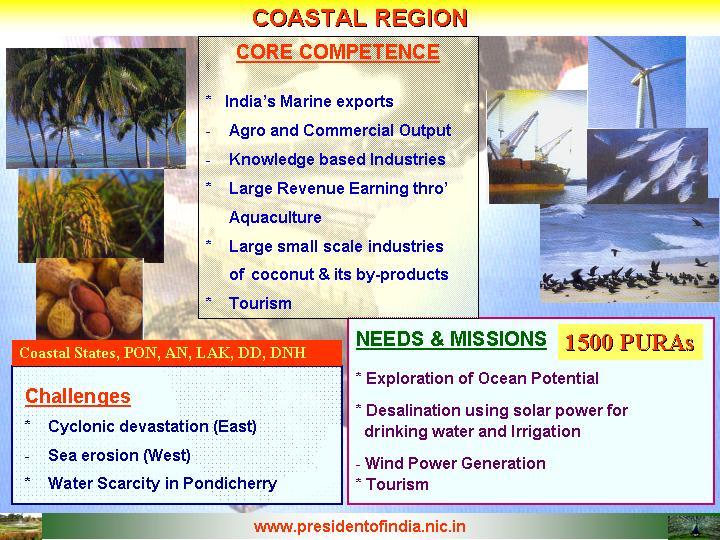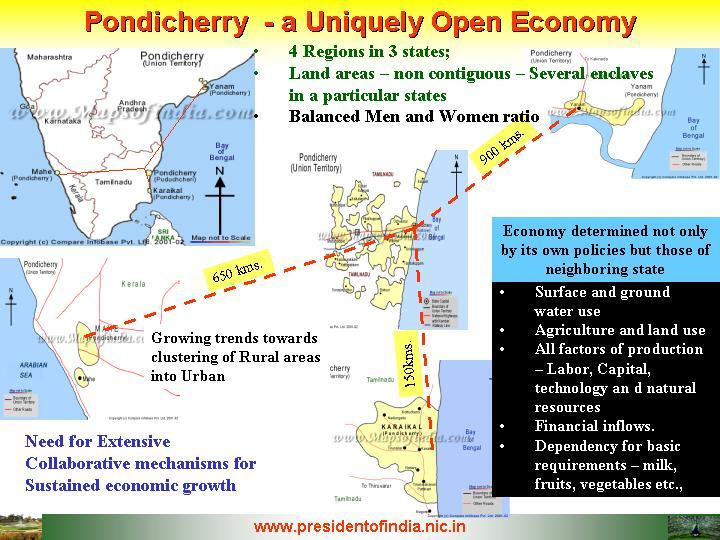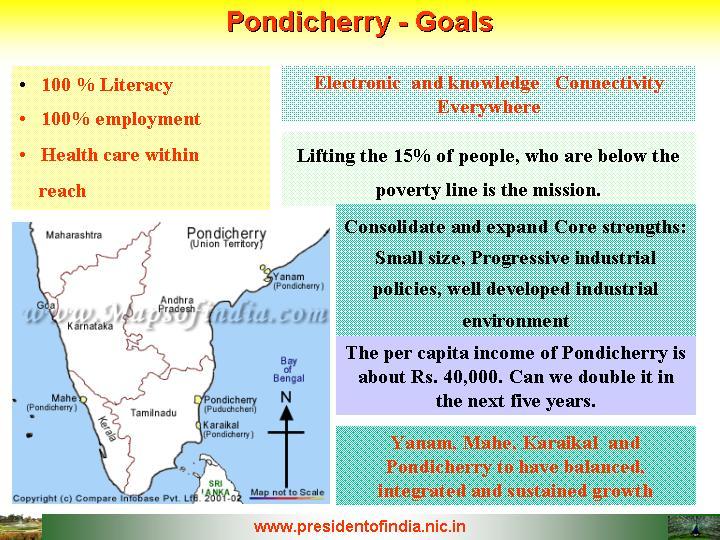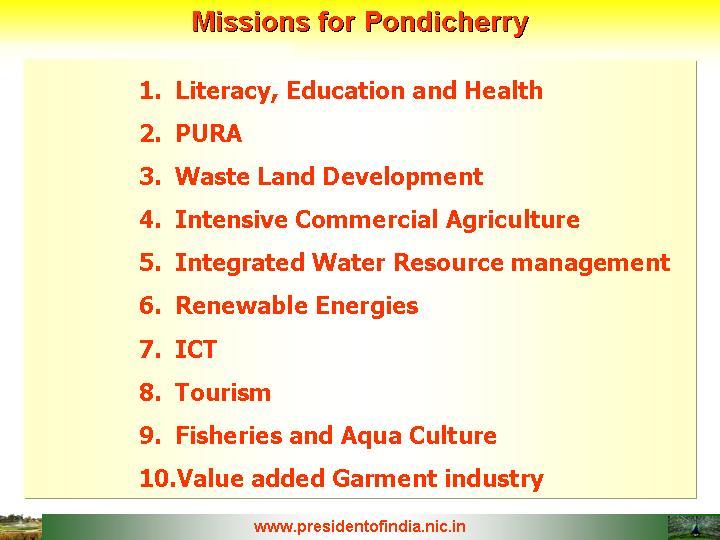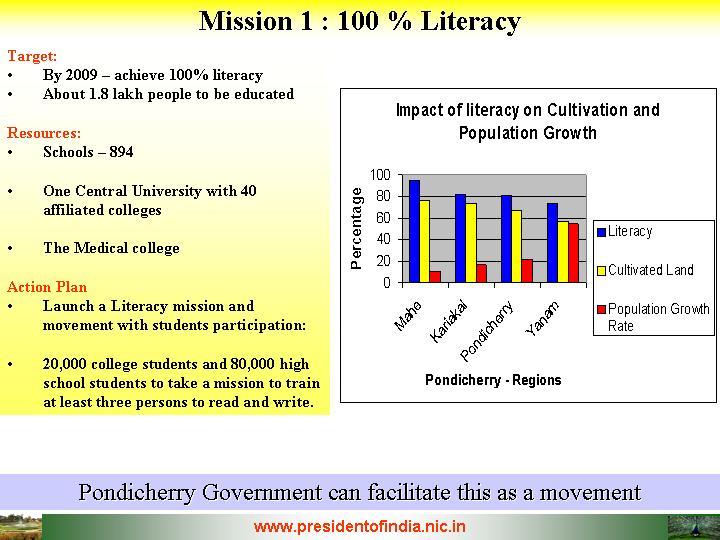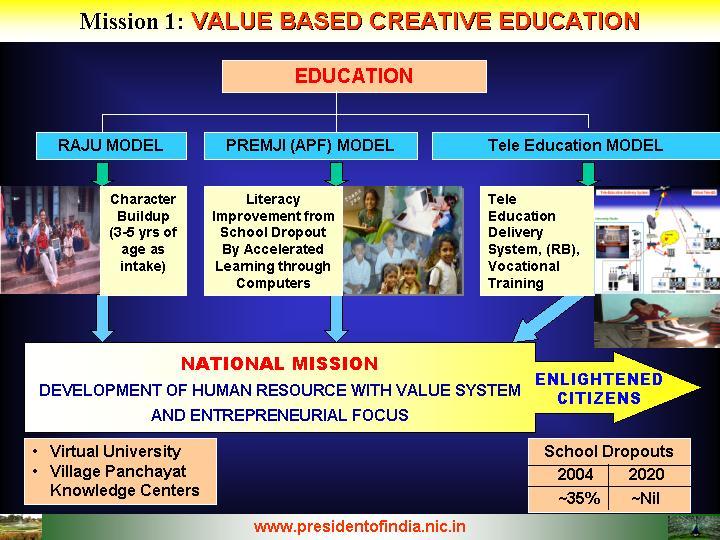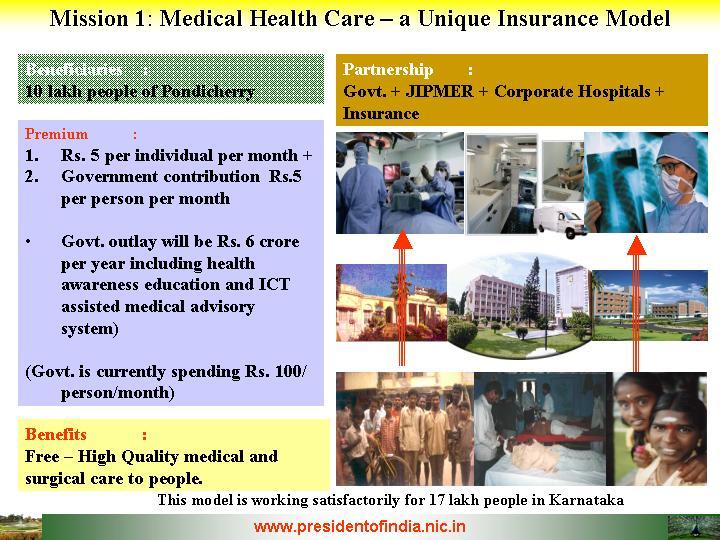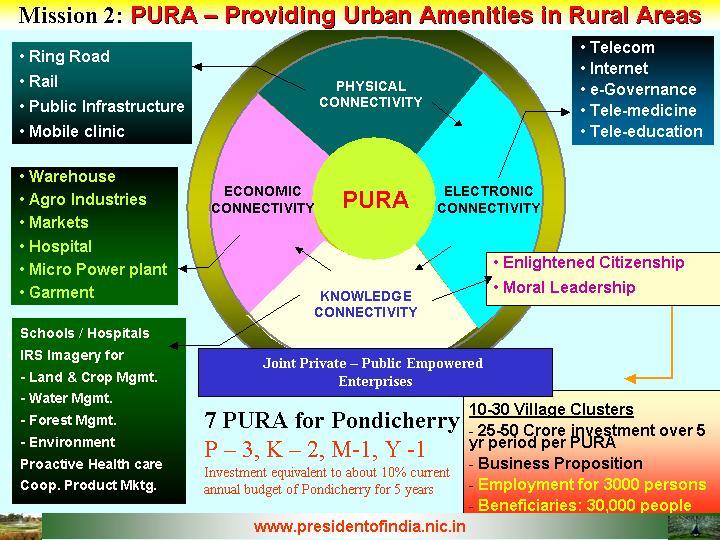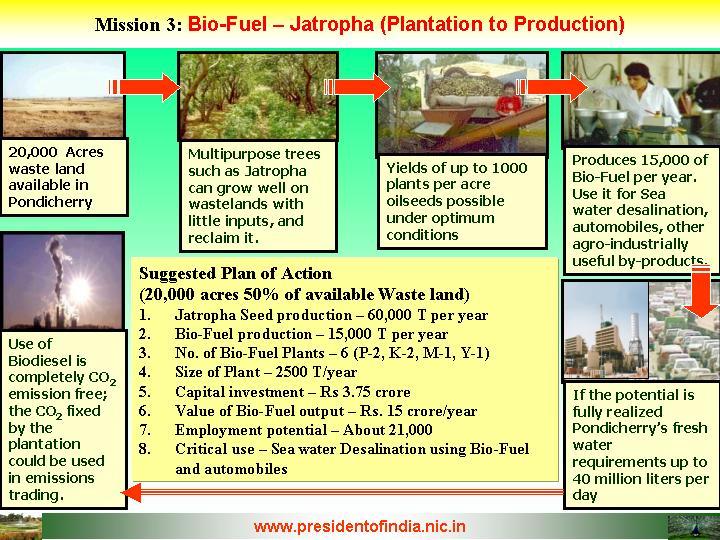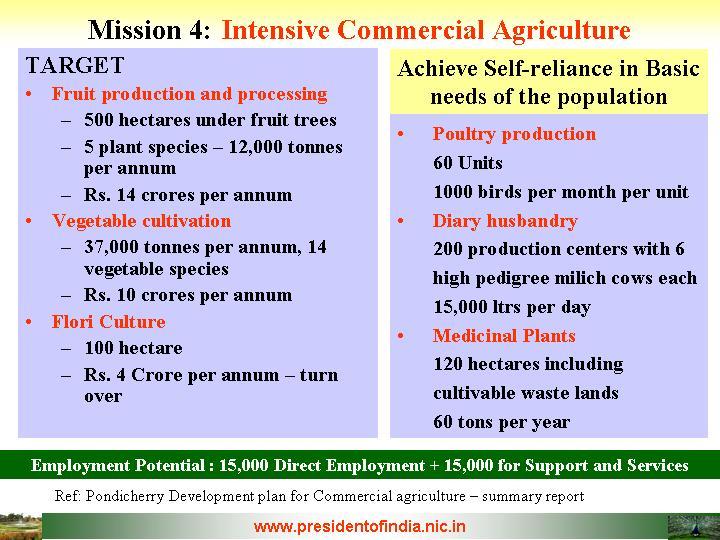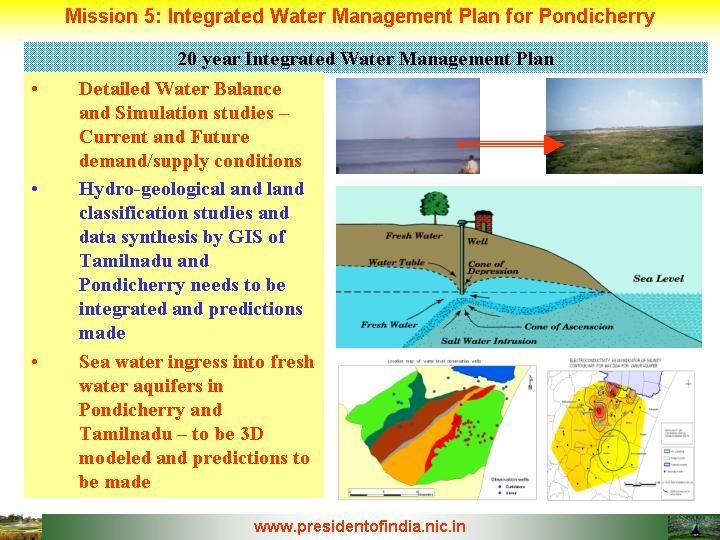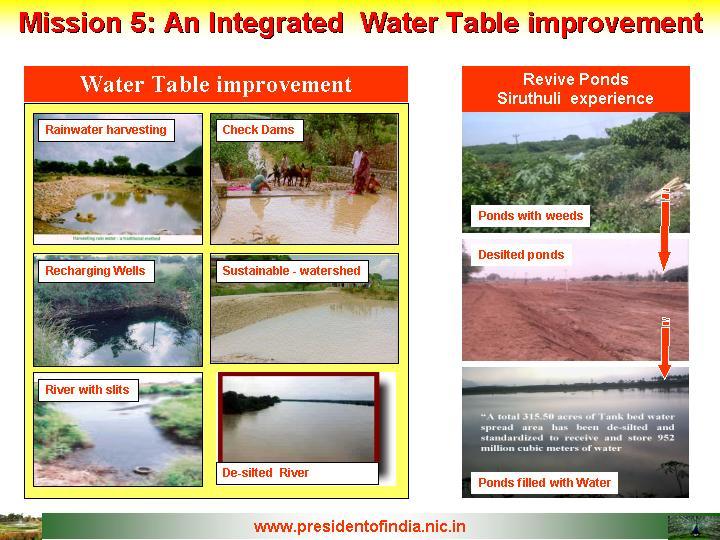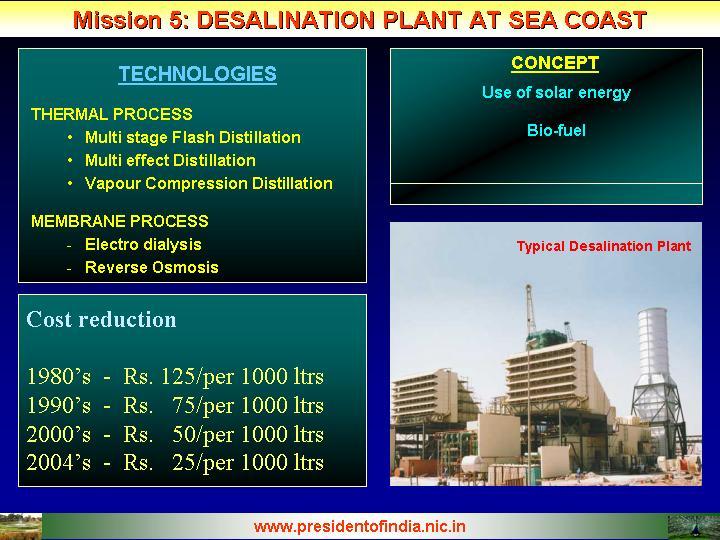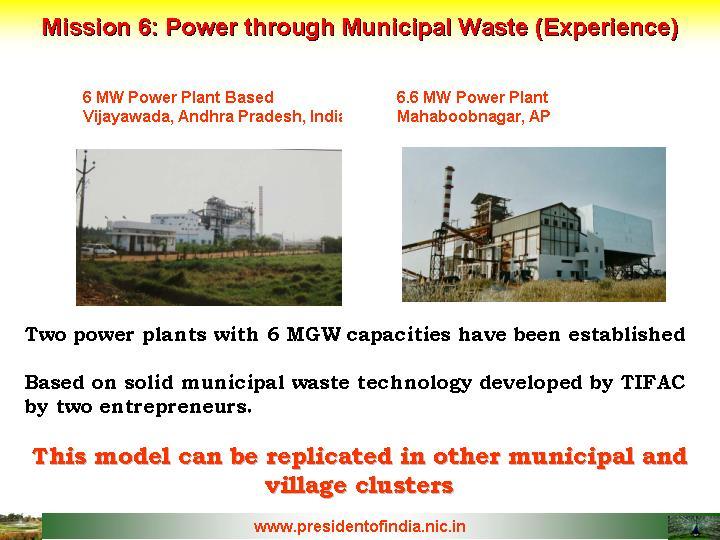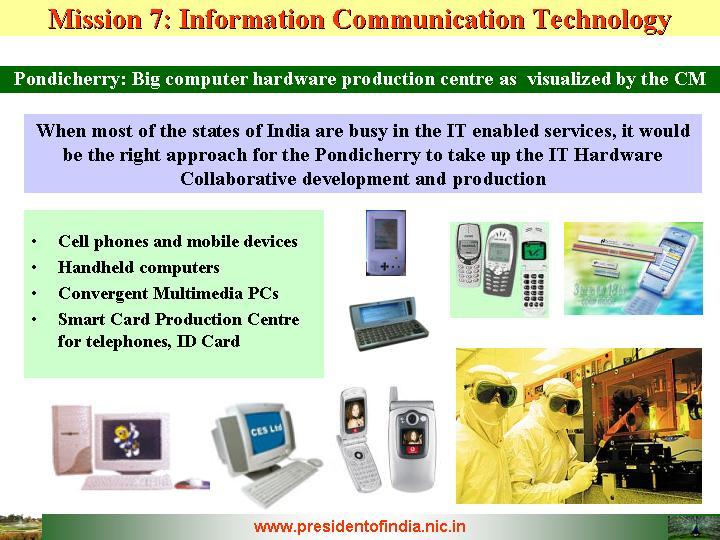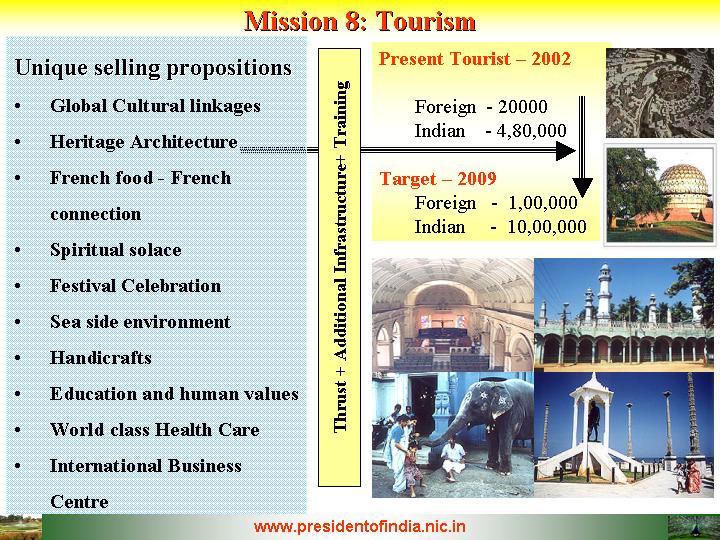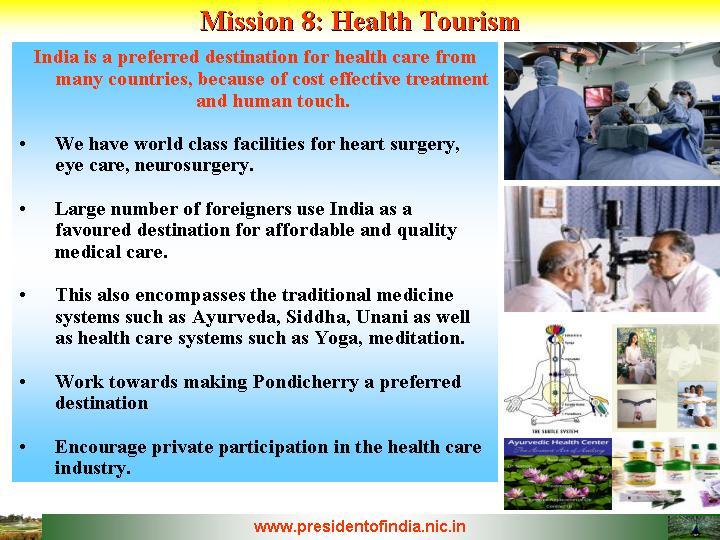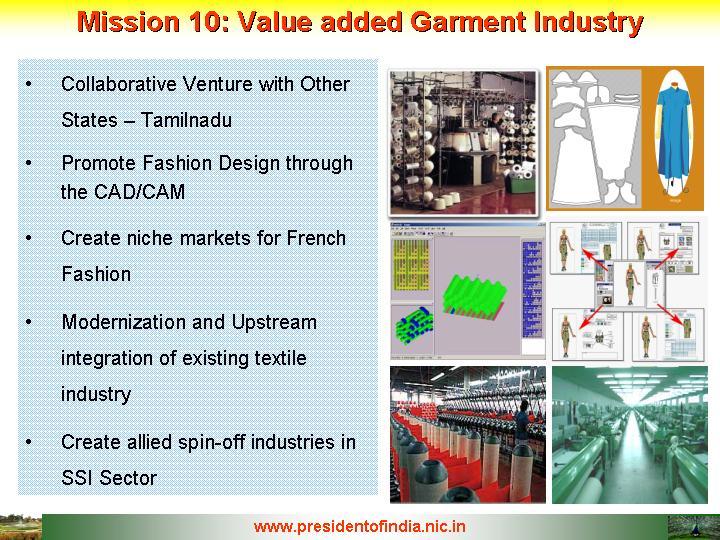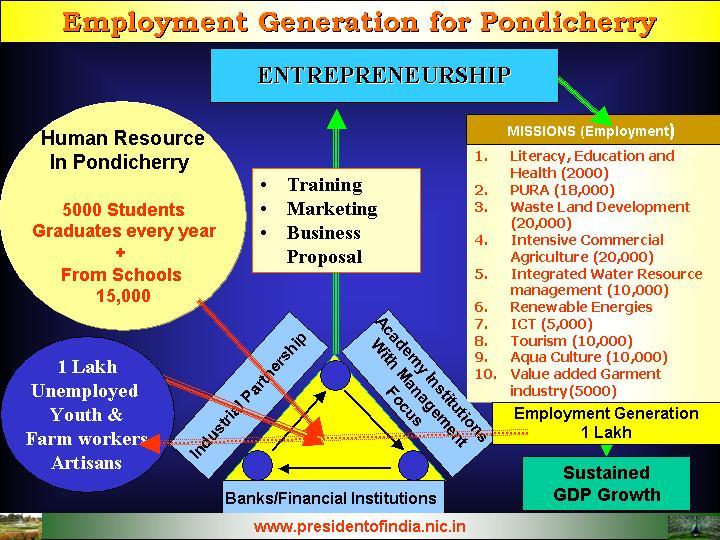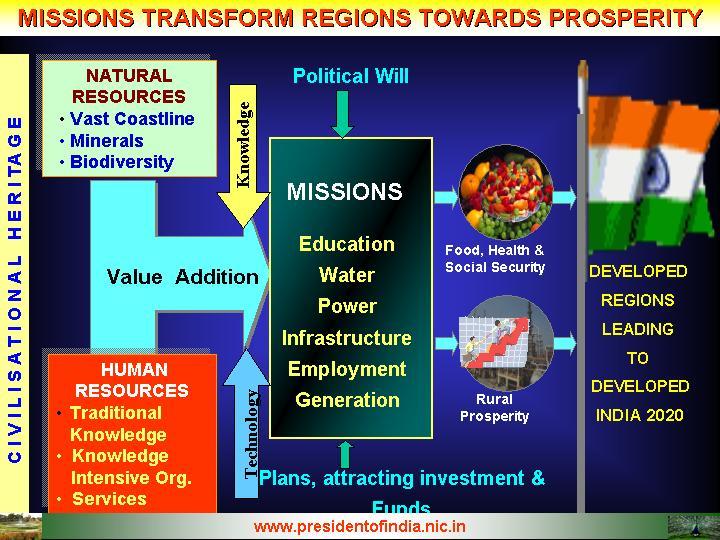Address To The Legislators Of The Pondicherry Legislative Assembly, Pondicherry
Pondicherry : 01-11-2004
Pondicherry: Missions for Prosperity
Hon'ble Lt. Governor, Mr. Speaker, Chief Minister, Leader of the Opposition, Ministers and Distinguished Members of the Pondicherry Legislative Assembly.
I am delighted to be here this afternoon to felicitate and share with you the joy of celebrating the Golden Jubilee of the merger of Pondicherry with the Indian Union. Let us salute those brave and selfless patriots who toiled and sacrificed so much, for the freedom of Pondicherry. This Golden Jubilee should spur us all towards greater and greater heights of prosperity and glory for this Union Territory and its people in the days ahead.
I am fascinated with the history and evolution of Pondicherry, which I have been privileged to visit for the second time. Pondicherry presents to the world an example of India?s skillful management of a unique open economy, which is flourishing, notwithstanding its geographical location of four regions in three different States. What better example can India present to the world of unity in diversity, love for preservation of diverse cultures, and a living example of an ambience where religion is flowering into true spirituality? What more can a person asks for than the peace and quiet ambience, beauty and enchantment that one finds here. This, in fact, might be considered as one of the most significant factors for the continued progress of the people of Pondicherry over the years.
The political history and economic growth of Pondicherry and all its regions is seen to be rhythmic and closely interactive with that of our nation as a whole. Your Assembly has witnessed and wisely guided several important phases of Pondicherry?s growth since early 1960?s. In the face of many limitations, your sincere efforts have placed Pondicherry on a high-growth track.
Our National Mission Challenges
Our nation is going through a major challenge of uplifting of 260 million people who are below the poverty line of whom 36 million are unemployed. They need habitat, they need food, they need health care, and they need education and employment finally resulting in a good life. Our GDP is growing at more than 6% per annum. Whereas, the economists suggest that to uplift the people below poverty line, our economy has to grow at the rate of 10% per annum consistently, for over a decade.
Integrated Action for Development:
To meet the needs of one billion people, we have a mission of transforming India into a developed nation. We have identified five areas where India has core competencies for integrated action: (1) Agriculture and food processing (2) Reliable and Quality Electric power, Surface transport and Infrastructure for all parts of the country. (3) Education and Healthcare (4) Information and Communication Technology (5) Strategic sectors. These five areas are closely inter-related and when effectively addressed, would lead to food, economic, energy and national security.
Engines for Growth
Emphasis should be on full utilization of natural and human resources of the region to meet the demands of the modern society. We should also remember that about 50% of our population is young people, with aspirations for a better life. Value addition to Agriculture, Manufacturing and Service sectors of the economy, building on the regions? core competencies and technologies, will lead to high income growth rate and employment potential. The engines for growth will be launching of the five national missions viz. water, energy, education and skills, infrastructure and employment generation, which will enable achievement of 10% GDP growth rate per annum, sustainable for a minimum period of ten years. Developed States result in developed India. Pondicherry is a trend-setter in this ascending phase of India?s development trajectory.
Pondicherry A Uniquely Open Economy in the Coastal Region
Our coastal regions have their own core competencies, face unique challenges and need new missions. Fifty years after Independence, the basic challenge before Pondicherry is to consolidate, sustain and expand its unique and broad economic perspective for its four regions and non-contiguous enclaves located in three States on both East and West coasts of India.
West coasts of India. You are truly enlightened and blessed with balanced demography of men and women, and growing trends towards clustering rural areas into urban-level prosperity.
Your economic policies are influenced by your own needs and also by needs and policies of contiguous States. This is particularly significant in the subjects of surface and ground water use, agriculture and land use, indeed all factors of production (namely labor, capital, technology and natural resources), and financial inflows.
Your uniqueness now calls for seeking self?reliance for basic requirements of the people such as milk, fruits, vegetables, eggs etc through well-organized cooperative agro-commercial programmes. Sustaining an environmentally conscious and holistic perspective in this region needs creation of extensive collaborative mechanisms for harmonious and accelerated economic growth.
Goals Strategies for Pondicherry
Considering these factors the goals for Pondicherry includes literacy, employment opportunities and affordable health care for all, and providing comprehensive electronic and knowledge connectivity. This will lead to prosperity for all by doubling the per capita income within the next five years through the use of Pondicherry?s core strengths, and formulation of progressive industrial policies towards a well-developed industrial environment.
Integrated Missions for Economic Development of Pondicherry
Dear Members, to realize these goals, I would now like to propose ten missions for the Union territory of Pondicherry.
These are Literacy, Education and Health Care, Providing Urban Amenities to Rural Areas (PURA), Wasteland Development, Intensive Commercial Agriculture, Integrated Water Resource Management, Renewable Energies, Information and Communication Technologies (ICT), Tourism, Fisheries and Aquaculture, and Value-added Garment Industry. I would like to discuss these missions in some detail with you.
Mission #1: Literacy, Education and Health Care.
When we study the economy of Pondicherry Union Territory in detail, with reference to Literacy, Population growth rate, cultivated land area, it can be seen in this slide, that higher the literacy growth rate, the population growth rate reduces and the cultivated land area increases. This result is for me, a very important relationship for national planning of development. This relationship emphasizes that education and particularly a liberal education with human values, is the answer to obtain prosperity and happiness for our people, through small families, wisely cultivated lands and the right choice of crops.
That is why, I suggest that Pondicherry should aim at a target of 100% literacy by 2009, i.e. within five years. You have a strong infrastructure base in education, nearly 900 schools, a Central University with 40 affiliated colleges and a renowned Medical College. I urge you to launch, without any delay, a well planned ?Literacy Mission? with student?s participation, and with inspiration drawn from the thoughts and human values of our nation?s great freedom-fighter, philosopher and saint, Sri Aurobindo, and the Mother, who had made Pondicherry their home.
This literacy mission should encourage and facilitate each of the 20,000 college students and 80,000 high school students to reach out to train and educate the people who cannot read and write. Then we shall witness a unique experiment where 1.0 lakh educated population reaching out to 1.8 lakhs people who today do not know how to read and write. I assure you that the results will be miraculous to set the tone and start a new wave of prosperity and happiness in Pondicherry.
Value based creative Education: Our aim is to develop human resources with value system and entrepreneurial focus, leading arresting the tendency of school dropouts and the generation of enlightened citizens. It can be achieved through incorporation of two models of education practiced in different parts of the country. I have come across Prof. MR Raju model at Peddamiram, Beemavaram District, Andhra Pradesh, where character building commences in the age between three to five. The child learns to become creative through love and affection, hygienic practice and nutrition. In the second model, practiced by the Azim Premji Foundation, literacy improvement is achieved through accelerated learning with the help of computer-based creative content for 1st to 8th standard. Children learn by themselves using computers. Teachers, parents, School Committee members become accountable for ensuring prevention of dropouts. With the improvement in tele-education technology it is possible to enable quality teaching to reach remote villages through a tele-education delivery system. Such a system developed indigenously has been implemented in Rashtrapati Bhavan as part of the President?s Virtual Institute of Knowledge (PREVIK). Particularly, all the four regions of Pondicherry should be interconnected with our recently launched geosynchronous EDUSAT in orbit. Also there is a need to promote education through virtual university and creation of village Panchayat knowledge centers.
Health Care: I suggest a unique insurance model for Pondicherry, where health care will be available within walking distance for each and every citizen. For providing comprehensive quality health care, we suggest citizens make a contribution of Rs. 5 per month and a matching Government contribution of Rs. 5 per month, which will lead to a Consolidated Health Fund of Rs. 12 crore per annum for the Pondicherry citizens. The Government contribution is only Rs. 6 crore. Currently Pondicherry Government is spending Rs. 100 per person per month on health care. This insurance system will pave the way for every citizen of Pondicherry to avail the services of any High Tech hospital for treatment, which is within the purview of this insurance scheme. This unique Health Insurance Model will include an Information Communications Technology assisted Medical Advisory System and Health Awareness Education over and above quality medical and surgical treatment and services to all the people. Such a model is already in operation in the Karnataka for the 17 lakhs people.
Mission #2: Providing Urban Amenities in Rural Areas (PURA)
Pondicherry and its regions are ideally placed for the implementation of PURA concept that is being tried out in some other States. This will enable interconnectivity of the non-contiguous enclaves of Pondicherry and make it a coherent economic planning zone. I would recommend creation a total of seven PURA units (3 for Pondicherry, 2 for Karaikal and one each for Mahe and Yanam). It will have special relevance to Pondicherry?s economy, because it will provide four critical connectivity?s between enclaves, which taken together are essential for accelerated economic growth: physical, electronic and knowledge connectivity, leading to economic connectivity. I shall describe these in some detail.
Essential Connectivities These are: physical connectivity of village clusters through quality roads and transport; electronic connectivity through tele-communication with high bandwidth fiber optic cables reaching the rural areas from urban cities and through internet kiosks; knowledge connectivity through education, skills training for farmers, artisans and craftsmen and entrepreneurship programmes. These three connectives will lead to economic connectivity through starting of new enterprises with the help of banks, micro credits and marketing of the products. The integrated method envisages a mission mode empowered management structure with executive powers at the local implementation levels and by reducing the transactional costs through simplification of procedures of governance.
The first thing that normally strikes one about Pondicherry is the impact of the Aurobindo Ashram on life in this region. Hence, so as far as spiritual connectivity is concerned, Pondicherry is already far ahead of the human movement for flowering of religions into spirituality.
I have always emphasized the imperative need to elevate religion to the level of spirituality and here I am seeing it in actual practice. Nothing gladdens my heart more than this. In fact I would say, this is the essence of the soul of this Union Territory that impels it forward by the innate forces of the Divine.
Creating such village clusters through PURA depending upon the region and population will cost between Rs 25-50 crores per cluster. A single PURA will have the potential to provide employment for 3000 to 5000 people. This has to be done by creating new market driven enterprises brought in by investors. If the industrial areas (IT, BT, Cottage industries) are marketed well, they can attract investors and thus lead to local wealth generation. Such value addition will also generate high value employment in service and support sectors. In addition, we need to promote entrepreneurship in the rural areas and equip people with skills for their own self-employment, meeting the needs of modern economy and society. Some of these persons may also turn out to be innovators and employment generators.
Mission # 3: Bio-fuel from Wasteland Cultivation
The total non-agricultural wasteland in Pondicherry is about 15,000 hectares or about 42,500 acres which is about 31% of the total land area in Pondicherry, Karaikal, Mahe and Yanam. Even if we transform 50% of this area to serve a Bio-fuel Mission, nearly 15,000 tonnes of bio-fuel can be produced from the four regions of Pondicherry in a manner that will serve to integrate their economies, ensure balanced economic growth and generate employment for about 21,000 persons.. This will need setting up of 6 plants at a total cost of about Rs 4.0 crores to process Jatropha seeds into bio-fuel, with each plant having an output of 2500 tonnes of bio-fuel per annum, yielding a total bio-fuel production turnover of about Rs 15 crores.
Using Bio-fuel to Produce Drinking Water from Seawater The normal use of bio-fuel is to be a substitute for diesel fuel for automotive and industrial purposes. However, for your coastal economy, I suggest a unique application of bio-fuel. Studies carried out in India show that perennial supplies of fresh water can be obtained in a cost-effective manner by desalination of seawater using renewable energies, a system and technology option which is particularly useful for population centers living on the coast line.
Pondicherry and its regions are also endowed with plentiful sunlight. Hence, small desalination plants can be set up at selected sites on the East and West coasts of India using solar energy and bio-fuel as hybrid renewable energy systems. The bio-fuel production from wasteland cultivation if used exclusively for production of sweet drinking water from the oceans will enable Pondicherry to create 40 million liters of fresh water daily from the oceans.
In this manner, Pondicherry can resolve major two problems with one integrated solution viz-productive use of wastelands and providing sweet drinking water to population centers living along the coastline, through use of new technologies.
Mission #4: Intensive Commercial Agriculture
This Mission is designed to create self-sufficiency in very essential needs of the population, which are currently being met from the contiguous States. This plan needs to be implemented with intensity and focus, in a cooperative mission mode, hence I have termed it as an Intensive Commercial Agriculture Mission. The proposals forming part of this mission are: Fruit Production and processing, Vegetable production, Flori culture, Poultry production, Diary Husbandry, and Medicinal plants. Taken together, this mission has the potential to provide about 30,000 employment opportunities for Pondicherry in about 750 hectares of lands spread in all its four regions.
Mission # 5: Integrated Water Resource Management.
I understand that in Auroville, a UNESCO endorsed International Seminar brought out the problem of seawater ingress into fresh water aquifers in Pondicherry and Tamilnadu. It is essential to formulate a 20-year Integrated Water Management Plan based on further detailed studies, and then implement the Plan, in an integrated manner. I shall now discuss about the immediate measures for water table improvement and establishment of desalination plants.
Water harvesting and Recycling: Water harvesting should become mandatory for all. To improve water table we need to build check dams; develop water sheds, de-silt ponds and rivers, clear the inlets and outlets to the ponds and water bodies and recharge the wells. If our rural areas are made to have the operational water bodies, recharging of the wells will take place automatically. These activities will also generate employment.
Water Desalination: In the coastal regions where ground water availability is scarce, India with large coastline of 7500 kms can afford to have number of seawater desalination plants using solar energy. I have seen many of the desalination plants in UAE, where the fossil fuel power sources are abundant. India should use solar power for desalination process, which will be cost effective. Desalination technology has advanced in such a way that there are plants in the world today, which can produce 1000 liters of potable water for Rs. 25. The allocation of special fund in the Central Government Budget 2004-05, brings out a necessity to have a mission-mode programme for setting up of desalination plants. For Pondicherry, it is equally important to plan such a desalination plant using solar power /bio-fuel.
Mission # 6: Renewable Energies
India?s power generating capacity is one-lakh megawatts. For meeting the development targets till 2020 our generating capacity has to increase to three lakh megawatts. This additional power has to come from nuclear energy, hydroelectric systems, renewable energy and thermal energy. The contribution of renewable energy especially from solar energy and wind energy has to be increased to one hundred thousand mega watts. Urgent measures are needed to reduce the distribution loss to less than 5% from the existing 25%. Use of bio-fuel has been discussed earlier for wasteland development mission, which has tremendous potential in the Pondicherry region.
Solar Energy: Productivity and profitability of farmers is affected by unreliable power supply, high cost of electricity, and availability only at night. With increasing demand for energy and increasing oil prices this problem is going to be more serious for farmers in the future. Installation of centralized solar photovoltaic systems, which can be fed to a grid, will be a long-term economically viable solution with added benefits of pollution control. We should build a few 100-megawatt solar power stations, capable of meeting the needs of the farmers with minimum maintenance expenditure. VLS-PV systems can be set up in Pondicherry regions, and gridlocked into the national electricity grid.
Power through Municipal Waste: Increased urbanization has led to a serious problem of accumulation of municipal solid waste in many towns and cities. Efficient and environmentally clean disposal of garbage has always been a major technological challenge. While being a threat to the environment, mounting garbage is also a rich source of energy. The potential for converting this waste into useable energy, which will eliminate a major source of urban pollution, was realized by one of our innovative organizations- Technology Information Forecasting and Assessment Council (TIFAC) of DST, which helped in developing a completely indigenous solution for the processing of waste into a source of fuel. This fuel could, in turn, be used for generation of electricity through mini-plants. Already in our country two plants, which generate 6.5 megawatt electric power using municipal waste bricks, are in operation. India needs thousands of mini power plants using municipal waste. This can be replicated in Pondicherry and its regions including cities and village clusters as an infrastructure build-up project with the aid of Corporate Houses. This project apart from being an employment generator will provide a clean environment for the people to live in.
Mission # 7: Information & Communication Technologies.
Pondicherry is emerging as one of the computer hardware production centers, as visualized by the Chief Minister. This is indeed the right approach, when most of the States in India are busy in the IT enabled service industries. A major mission for Pondicherry is suggested, for collaborative development and production of many high technology, high value-added products like cell phones, mobile devices, handheld computers, convergent multi-media PC?s, Smart Cards for telephones, ID cards etc. The time is now ripe for Pondicherry to enter into this growing Services sector of the national economy.
Mission # 8: Tourism:
Tourism is a major mission and has a tremendous potential for growth in this beautiful territory. The unique contribution that Pondicherry has made to tourism is the preservation of its architectural and civilizational heritage. I am confident this will continue far into the future.
Pondicherry with its unique ?tourist selling propositions? can well afford to set an ambitious target of doubling its Indian tourist inflow, and enhancing foreign tourist inflow by a factor of five in many areas of interest to the tourists. This would demand thrust and additional infrastructure, and high level of training to handle the higher volume of tourism. The unique selling propositions are Global Cultural linkages, Heritage Architecture, French food and various varieties of Indian food, Spiritual solace, Festival Celebration, Seaside environment, Handicrafts, Education and human values, Quality Health Care and International Business Centre.
Health Tourism: India is a preferred destination for health care from many countries, because of cost-effective treatment and human touch. Pondicherry should aim to emerge as a preferred destination for Health Tourism. Health centers, infrastructure and effective management structure has to be evolved.
Mission # 9: Fisheries and Aquaculture
As you are all well aware, India is very advanced in building and launching satellites for remote sensing of earth resources. Satellite observations are now able to locate fish-rich areas and give advance warning to the fishermen. Fishing boats can then be guided to these fish-rich areas using GPS and simple satellite image receivers.
Thus, Pondicherry and its regions that are all located on the seacoast have now the opportunity to develop deep-sea fishing, on-ship processing, and marketing at sea through high-sea sale. Inland aquaculture in tanks and farms need to be expanded to produce protein-rich fish and yield better returns to the farmers.
Mission # 10: Value-added Garment Industry
Pondicherry has an established textile industry, which needs strategies and policies to grow further. Modern textile industry world-over has expanded their domain of operations by both backward and forward integration of textile industries. Since Pondicherry and its regions are not endowed with black cotton soil, the option left with us is forward integration of the textile industry with value-added Garment Production. This could be undertaken as a collaborative venture with the other States. Modern textile technology enables advanced fashion design and manufacture through the use of Computer Aided Design and Computer Aided Manufacturing.
Considering the historic association of Pondicherry with France and other European countries, upstream integration in fashion design market could naturally blend with niche markets specially created for India and Europe. All these activities into Computer Aided Fashion Design would require modernization of plant and machinery in the existing textile industries. Such an enlightened approach to sustained growth of textile industry, through public-private partnerships in this region, would create spin off industries in the small-scale industrial sector. This would enlarge prosperity over a wider cross-section of the region.
Arts and Crafts
Apart from these specific missions, arts and crafts can also contribute to the progress of this territory that has been well known for its traditional doll making, pottery, leatherwork, aromatics and handmade paper. With its rich cultural background spanning over decades of combined histories of many of civilizations of the world, antique industries hold forth an excellent future. Perhaps some such boutiques and furniture galleries have already come up and they need sustained encouragement.
Employment Generation through Entrepreneurship:
There has been substantial growth in the Pondicherry?s higher educational system and we are generating over 5000 graduates every year, and also after 10th class and Ten-Plus-Two nearly 15,000 youth seek employment. In addition, the Pondicherry region need employment for over one lakh youth. However our employment generation system is not able to meet this need in full. There is a mismatch between the skills required for the modern economy and the education imparted to most of these students. In addition, economic growth and investments have not kept pace with the availability of human resources. This situation will lead to instability in the social structure. We need higher education focused on and oriented towards high value and productive employment opportunities. A three-pronged strategy is needed. The first is to make education more attractive. The second, make it skill imparting finally create employment potential ? how do we do that?
Firstly, the educational system, in addition to the regular curriculum, should highlight the importance of entrepreneurship and prepare the students right from the college education to get oriented towards setting up of the enterprises which will provide them creativity, freedom and ability to generate wealth. Diversity of skills and perseverance in work makes an entrepreneur. It should be taught to all the students. In addition, college syllabi even for arts, science, and commerce courses should include topics and practicals where such entrepreneurship is made possible. Secondly, the banking system should provide venture-capital right from every village level to the prospective entrepreneurs for undertaking new enterprises. Banks have to be proactive to support the innovative products for enabling wealth generation by young entrepreneurs, by setting aside the ?conventional tangible asset syndrome?. Definitely this involves certain amount of calculated risks, which can be eliminated by making an analysis of successful venture capital enterprises. Thirdly, there has to be an economic pull for human resources; for example, generation of marketable products and enhancement of purchasing power among the people.
The ten missions that, I have suggested above have the potential to create employment for over one lakh people of Pondicherry leading to the full utilization of the human resource and sustained GDP growth.
Ten immediate missions
Dear Members, may I now summarize the ten important missions for your consideration and implementation for sustained prosperity and empowerment of Pondicherry and its regions besides providing employment opportunities for over one lakh of the people of Pondicherry and its regions.
1. 100% literacy for all and Health Care for through Medical Insurance.
2. Establishing 7 - PURA clusters (P3, K-2, M-1, Y-1).
3. Waste Land Development ? 20,000 acres leading to 15000 tonnes of bio-fuel per annum.
4. Total self-sufficiency in milk and dairy products, vegetables, fruits, poultry through intensive Commercial Agriculture.
5. Sustainable Water Resource management and arresting further penetration of salinity and setting up of small desalination plants with renewable energies.
6. Establishment of 100 mega watt (VLS-PV) solar power stations, 6 Bio-fuel production plants each of 2500 tonnes per year capacity and 7 units each of six megawatt municipal waste based power plants Renewable Energies.
7. ICT business alone has to generate revenue of Rs. 500 crores.
8. Thrust in infrastructure for doubling of our tourist arrival and increasing the foreign tourist visits by a factor of five.
9. Aqua Culture and deep sea fishing added with high sea sales should lead to the target of Rs. 300 crores business per year through a collaborative programme.
10. Establishing value added Garment industry with an export target of Rs. 1000 crores.
Conclusion
God has given us such a beautiful atmosphere, spiritual peace, amity, unity and above all a wonderful and bountiful nature. Pondicherry has this spiritual atmosphere and the educational, economic and other infrastructure to bring this about. What is needed is sustained hard work to achieve these missions. Five lakh youth of Pondicherry are the most powerful resource to transform these missions into reality. Developed Pondicherry will add strength to the prosperity of Developed India. That is the surest way to ensure a bright future for you and the posterity.
My best wishes to all of you for success in these missions.
May God bless you.
Documents

